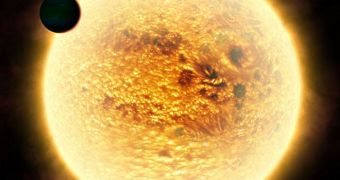Researchers looking at the renowned exoplanet WASP-12b have recently determined that the celestial body doesn't have much to live. Its parent star, a Sun-class yellow dwarf, is currently engulfing matter from its atmosphere, and is also deforming the overall shape of the planet. The celestial object already looks like a football rather than a sphere, and astronomers believe that the huge tidal forces at work in this system will soon destroy the exoplanet altogether, Space reports.
The latest data from the Hubble Space Telescope would seem to indicate that WASP-12b only has about 10 million years left. Though that may seem like a lot in human terms, it's merely the blink of an eye in cosmic times. According to the announcement the Hubble team made yesterday, May 20, it would appear that the planet has an average surface temperature of 2,800 degrees Fahrenheit on the side that is exposed to the star. The two bodies are tidally locked, which means that the exoplanet always keeps the same side oriented towards its star. The Moon is also tidally locked to Earth.
“We see a huge cloud of material around the planet which is escaping and will be captured by the star. We have identified chemical elements never before seen on planets outside our own solar system,” explains The Open University expert Carole Haswell, who was the leader of the new investigation. It was additionally found that the atmosphere surrounding WASP-12b currently occupies an area about three times larger than the radius of Jupiter. The exoplanet itself is about 40 percent larger than our own gas giant is. The new research was conducted using the recently-installed Cosmic Origins Spectrograph (COS) instrument. It was delivered to the telescope by Atlantis astronauts, in May 2009.
In a paper appearing in the May 10 issue of The Astrophysical Journal Letters, researchers explain that the new observations are actually a confirmation study. Back in February, Peking University astronomer Shu-lin Li published a paper in the esteemed scientific journal Nature, predicting that WASP-12b would be deformed by the massive tidal forces acting on it. The new Hubble study represents the first instance when this idea has been tested directly. The work was only made possible through the unprecedented ultraviolet (UV) sensitivity that the new spectrograph has.

 14 DAY TRIAL //
14 DAY TRIAL //